by Chris Punnett (Author of .30-06. A hard-bound 384-page volume covering the development and production of the .30-06 in 48 countries from its inception to the early 1990s
Copies available from booksellers, or from the author[email protected].)
The .30-06 cartridge can be looked at as the result of several
different developments that took place during the closing decades of the nineteenth
century. These developments were: the change from blackpowder to smokeless powder;
the general acceptance throughout the world of the benefits of smaller caliber
weapons; and the desire to move away from a rimmed cartridge. The move to smokeless
powder and smaller diameter bullets had been accomplished to some degree with
the adoption of the rimmed .30 Krag in 1892 but this proved to have a limited
powder capacity. By 1901, work had started on a rimless cartridge which was
based on an earlier rimmed experimental .30 caliber round. The result of this
work was the .30 Ball Model of 1901 – the “.30-01” or “Thick-rim”.
As its name implies, the rim on this cartridge was thick in comparison to more
modern rimless cartridges including the .30-03 and .30-06 which followed. The
bottle-necked case held a 220-grain round-nosed cupronickel-jacketed bullet.
>Running parallel to this was the development of the Springfield Magazine
Rifle. By 1903, the original .30-01 cartridge had lost its thick rim and had
been adopted as the .30 Model of 1903 – the “.30-03”, and in the same year the
Springfield was also adopted as the .30 Rifle, Model of 1903.
The .30-03 retained the 220-grain round-nosed bullet of its predecessor
at a time when most world powers had realized the advantages of a pointed or
“spitzer” bullet. In early 1906, a pointed bullet was mounted on a .30-03 case
that had the neck reduced by a tenth of an inch to accommodate the reduced bearing
surface on this new bullet. Thus, on October 15, 1906, with little fanfare,
was born the .30 Cal. Model of 1906 – the “.30-06”.



From top: .30 Ball Model of 1901 – “.30-01” or “Thick-Rim”
.30 Model of 1903 – “.30-03”
.30 Model of 1906 – “.30-06”
From these humble beginnings, the .30-06 became one
of the most popular military and sporting cartridges in the world, being manufactured
in almost fifty countries. To be fair, its popularity was a reflection of the
economic and political power of the U.S.A. rather than just the cartridge’s
performance and flexibility.
As well as being manufactured all over the world, the .30-06 was the
official U.S. rifle and light machine gun cartridge through two World Wars
and countless “Police Actions”. Nothing generates small arms development
like a good war and the .30-06 was no exception. Many of the experimentals
and limited-issue rounds are available to collectors (some of these are
covered later in this article). Military production started in 1906 and
was still going strong in Denmark in the 1990s though U.S. Military production
effectively ceased in the 1960s except for match rounds. Sporting rounds
are still made by a large number of U.S. and foreign manufacturers. The
latter often refer to the .30-06 as the 7.62×63 – the “63” referring to
the case length in millimeters.
World War II provided the U.S. with the opportunity to expand its influence
and what better way than to provide friendly foreign powers with your excess
weaponry. These countries quickly realized the benefit of making their
own ammunition and many performed a great deal of experimentation of their
own.
This huge amount of development plus the variety of loads designed by
practically every sporting ammunition manufacturer in the world poses somewhat
of a dilemma for the novice .30-06 collector. A conservative estimate of
the number of variations of the .30-06 cartridge, if one counts headstamp
dates and the different hunting bullets, is in excess of 10,000 rounds.
A good box collection can run in excess of 750 boxes.
So how do you collect? Do you go for every variation from every manufacturer
or do you concentrate on U.S. Military? Do you collect boxes (full and/or
empty)? How you decide to collect .30-06 depends mostly on what gets you
excited, with a few “minor” considerations like space and money.
To help you decide, here’s a list of countries known to have made .30-06:-
| Argentina
Australia Austria Belgium Brazil Cambodia Canada Chile China (Comm) China (Nat.) Colombia Czechoslovakia Denmark Dominican Rep. Ethiopia Finland |
France
Germany Greece Hungary India Indonesia Iran Israel Italy Japan Korea Mexico Morocco Netherlands New Zealand Norway |
Pakistan
Philippines Poland Rep. South Africa Russia Saudi Arabia S. Vietnam Spain Sweden Switzerland Syria Thailand Turkey UK U.S.A Yugoslavia |
Typical military loadings will include: Armor-piercing (AP), AP-Incendiary,
Ball, Blank, Dummy, Gallery, High Pressure Test, Incendiary, and Tracer. Many
of these will be identified by colored bullet tips. The following is a list
of commonly found colored bullet tips on .30-06.
- Black: AP
- Black/Silver: AP Plate Test
- Blue: Incendiary (also tracer from Argentina)
- Green: AP from UK, Tracer from Argentina
- Green/White: Frangible
- Green/Tan: Frangible
- Orange: Tracer
- Red: Tracer (also some Incendiary from UK, and AP from Argentina)
- Silver: Armor-piercing Incendiary
- White: Tracer, unfinished Frangible,
- Yellow: Observation and Proof rounds (AP from Belgium)
The new collector is warned that there are exceptions and, in addition, beware
of the WWII habit of dipping the tips of ordinary cartridges into paint to mark
targets. For the latter, look out for thick or unevenly applied paint that is
flaking off. For the rarer .30-06 with exotic color codes one should also be aware
that these are often faked as genuine ones fetch high prices.
Perhaps the best way to introduce someone
to .30-06 is to go through the various loadings, provide some background information
and things to look out for.
Ball
In the U.S. the Ball round was originally loaded with a 150-grain cupronickel
jacketed bullet referred to as the “M1906” bullet, for obvious reasons.
WWI made the military rethink this as the use of machine guns at relatively
long range required a heavier bullet. Towards the end of WWI and for several
years after, the U.S. experimented with different heavier bullets. Many
different types were tried, including even a boat-tailed version of the
round-nosed Krag bullet! This series of tests is often referred to as the
“Daytona Beach” tests after the place where some of the test firings were
conducted. The tests eventually resulted in the adoption of the M1 bullet
– a 172-grain boat-tail with a gilding metal (copper alloy) jacket. These
Daytona Beach test round are not uncommon and the telltale sign on the
common ones is a slightly more pointed ogive (see illustration below).
This M1 bullet survived the period between the two World Wars but as hostilities
looked inevitable, the U.S. Military realized that though the 172-grain
M1 was great in machine guns it was not going to be pleasant to fire from
the shoulder for the average GI. The remedy was simply to go back to the
M1906 bullet, give it a gilding metal jacket and call it the “M2” ball
bullet. This was adopted in 1938.
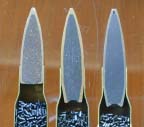
From left: the M1906, M1 and a Daytona Beach test bullet
One thing to look out for from this period is ball rounds with a silver
tip, headstamped F A 41. These were an M1 Ball contract for the U.S. Navy
and were given a silver tip to distinguish them from the M2 ball rounds
which were in service by then. The lot number was 2160 and you can sometimes
find sealed boxes of these where the seller is unaware of their silver
tip. Ball rounds with silver tips headstamped F A 41 are often sold as
Armor-piercing Incendiary (API) rounds but the silver tip ID for API rounds
didn’t appear until 1943.
Foreign countries normally followed the U.S. standards for ball rounds with
the majority using the 150-grain bullet except where match rounds are concerned.
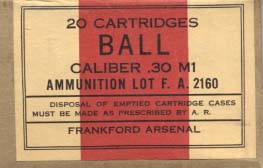
Armor-Piercing (AP)
The earliest AP rounds that you are likely to encounter is the M1917
with its lead bullet tip – occasionally mistaken for a hunting bullet in
a military case – usually headstamped FA 17 or F A 18. The Hague Convention
of 1899 (Not the Geneva Convention as some would have you believe) banned
the use of expanding bullets on personnel. As a result, the M1917 AP round
was short lived as senior officers objected to using it on the grounds
that servicemen captured with this in their possession were likely to be
treated very harshly. The quick solution was to apply a full jacket to
the bullet and call it the M1918. Both the M1917 and the M1918 had cupronickel
jackets. The M1918 can be recognized by the ring on the bullet jacket just
above the case mouth.
While further experimentation after WWI was limited, there is one or
two experimental-type AP rounds that you can spot if you know what you’re
looking for. The first is what is referred to as the “M1920” on a case
headstamped F A 20. This boat-tailed bullet with a cupronickel jacket has
a magnetic core which the discerning collector will spot with his trusty
magnet. The second AP round to look out for has an exposed steel point
but with a very rounded ogive. This is what is called the Tull Bryant bullet
and it dates from 1932.
Starting in the early 1930s, there was a huge amount of experimentation
on high velocity armor-piercing bullets and these are not uncommon. Many
of them featured reduced surface areas with narrow driving bands and cannelures
on the case neck. Some had black bullet tips, many did not, and one has
a small red tip but it is extremely rare. The tests continued through 1938
though one of them was adopted earlier as the M1 AP which was a high velocity
round with a black tip and a faint raised band just above the case mouth.
In 1939, the U.S. adopted the AP M2 which had a flat based bullet weighing
163-168 grains and identified by a black bullet tip. This remained the
standard .30-06 AP round until the caliber was phased out.
One things to look out for at gun shows is Plate Test AP rounds and
their boxes. These were AP rounds that were loaded to a certain velocity
for testing armor plate. Early rounds were not identified any differently
than standard AP rounds and once out of their box they are difficult to
identify. Some have black tips and also a wad of cotton over the powder
charge. If you shake an AP round and you cannot hear the powder move it
is possibly a Plate Test round. Later Plate Test rounds were identified
by black and silver bullet tips.
One interesting thing about the boxes for Plate Test rounds is that
they are often hand labeled identifying the velocity to which they are
loaded and the name of the company making the armor plate to whom they
were to be shipped.
Foreign AP round usually followed the U.S. standard bullet design and
color coding. The exception is the AP from Argentina that has a red bullet
tip and the British AP round which has a green bullet tip.
Another AP round to keep an eye open for is the WWI contract assembled
in the UK for the U.S. These used U.S. cases and British bullets with cupronickel-clad-steel
jackets and were identified by a green band at the case mouth. Headstamps
of W.R.A.Co. 18, F A 18, and U.S.C.Co. 18 may be encountered.
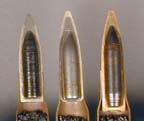
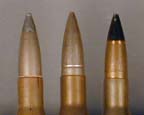
From left: The M1917, M1918, M2 – sectioned and full views.
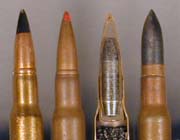

From Left: High velocity tests: black tip (F A 35), red-tipped T6 (F A 34)
which had a blunt steel slug (shown sectioned); the Tull Bryant bullet (FA
32); early Plate Test headstamped F A 33 and the later style headstamped F
A 42.
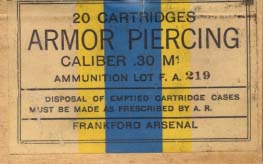
AP M1 High Velocity
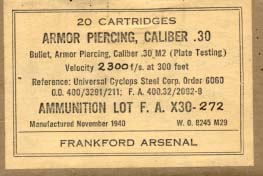
Plate Test AP
AP-Incendiary
The challenge of getting any worthwhile incendiary effect from such
a light bullet plagued the .30-06 its entire life. Early tests in WWI were
conducted but no specimens have ever turned up. Experiments in WWII substituted
the lead point filler in the standard armor-piercing round with a barium
nitrate/magnesium mixture called IM-11, The first ones had a black and
blue bullet tip but these are rare. Later ones (1943) used a silver tipped
bullet as identification. The early designation was T15 but this changed
to M14. It wasn’t until the late 1940s that a different approach was taken,
with a change in the core shape, that any meaningful incendiary charge
could be contained in the .30-06 bullet. This was adopted as the M14A1
(see illustration below).
Foreign API rounds are not common as most countries seem to have abandoned
the concept in such a small caliber. The United Kingdom, Belgium and Yugoslavia
produced some – also identified by a silver bullet tip. In addition, the
UK produced an experimental one (internal details unknown) that was identified
by a red `splash’ on the bullet on a case headstamped K60 .30.
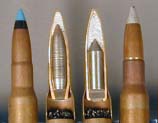
From left: the early T15 color code with sectioned bullet showing
the tiny amount of incendiary compound; sectioned M14A1 with complete round
next to it.
Blank
Blanks served a variety of purposes rather than just as an expression
of enthusiasm on July 4th. Apart from saluting (ie: noise), blanks were
also used to launch rifle grenades, radio antennas, and in movies to function
weapons.
The earliest form of noise blank was a paper bullet loaded into the
.30-06 case. Initially these cases were tinned but this was stopped and
plain brass cases were used. In 1909, batches of the .30-03 paper-bullet
blanks had their necks resized to fit the .30-06 chamber. These can also
be found with both tinned and plain brass cases. The blanks actually had
a second powder charge in the bullet to ensure that it broke up.
These paper-bullet blanks were expensive to make and by 1909 a much simpler
blank with a standard case crimped over a cup-shaped lacquered wad was introduced
as the M1909. While the cup-shaped wad was replaced with the more familiar red
card wad, the design remained virtually unchanged for the life of the caliber.
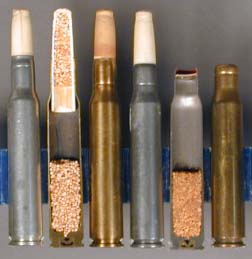
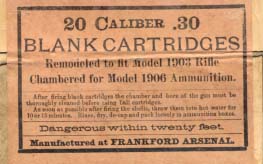
Noise blanks from other countries are a lot more colorful than those in the
U.S.. Many countries experimented with plastic cases, and paper and wood bullets.
France used white and translucent plastic for blanks and they also had a version
that used gold plastic for the movie “The Longest Day”.
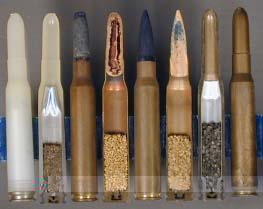
French blanks: Plastic, paper bullet, wood bullet, gold plastic
Norway was also using plastic for blanks and also tried aluminum. Their
Raufoss plant experimented extensively with aluminum blanks with plastic
bullets in the late 1950s and these are prized by the .30-06 collector.
The tremendous variety of foreign blanks would take an article of their
own.
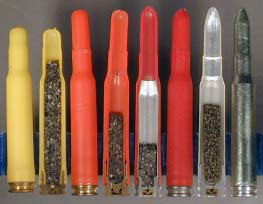
Norwegian blanks: Yellow (rifle grenade), red plastic with Berdan primer,
red plastic with aluminum reinforcing tube, and all aluminum experimental
blank with plastic liner.
One of the other uses for blanks was propelling grenades. The earliest
ones are sought after by collectors and though some are not rare they are
difficult to find unless one gets to acartridge show. Because these early
grenade blanks used a small charge of blackpowder with the smokeless propellant,
the cases deteriorated and finding ones in good condition is hard. Early
ones were also headstamped with their purpose CWG – “Chemical Warfare Grenade”,
CRG – “Chemical Rifle Grenade”, or just plain RG – “Rifle grenade”. These
normally have a standard case with a 5-point crimp. Eventually these became
standardized as the M1 grenade blank. This has a crimped case with a cannelure
on the case neck. The M2 and M3 grenade blanks were identical but for changes
in powder charge and were made for many years.




Headstamps from Blank Cartridges
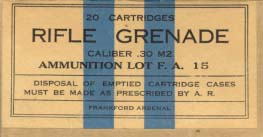
One rather unusual but not uncommon grenade blank made in the U.S. has
a wood bullet. This was for the Viven-Bessières grenade which was
launched by a ball round where the bullet actually went through the center
of the grenade. This presented a problem as the danger space for the ball
rounds exceeded that of the grenade and training could only be carried
out on grenade ranges with sufficient space. So a blank with a solid wood
bullet was developed. These are found on cases headstamped F A VB 33, F
A 21-R and others.
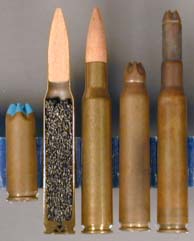
From left: Antenna Erector, V.B. grenade blank, standard M3 blank and
the rare M3E1 headstamped F A 53.
Another round to look out for is the Antenna Erector blank which normally
uses a shortened case with a blue crimp (see photo above). This was for
launching the antenna on remote radios. It was also made in a standard
length case like a normal rifle grenade blank but also with a blue crimp.
Regrettably this is also often faked.
You may occasionally encounter blanks which have numbers or the word
“Full”, on the wad. These are some of the quite common movie blanks made
by companies like Stembridge Gun Rentals. As the name implies they were
made in great quantities for the movie industry using any cases available
and with virtually any sort of case crimp.
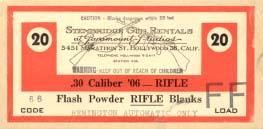
Movie Blanks by Stembridge
It should be remembered that not all crimped blanks are grenade launchers.
Dummy
The earliest U.S. military dummies had tinned cases with 6 “flutes”
(grooves running along the case), and 4 holes drilled in the case below
the flutes. This early form of dummy (referred to as the M1906) was replaced
with a very similar one
but with 3 holes in the flutes. This was also changed to one hole and
then no holes at all, eventually being referred to as the M40 by which
time the tinned case had been dropped in favor of plain brass or steel.
Any cases were used, including rejected cases and occasionally cases intended
for match rounds. There was also a series of smooth-case dummies without
these flutes but with 1, 2 or 3 holes in the case, the latter being called
the M2. Keep your eyes open for the Range Dummy. This round looks like
a normal ball round except it has a groove cut in the head near the rim.
This was used by instructors who sneaked the round into a recruit’s magazine
to detect flinching.
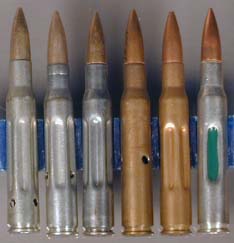
Dummies: First 3 are M1906 dummies with the second one having an experimental
neck crimp. M2, M40 and a Remington contract for the RAF with green flutes.
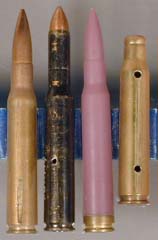
Dummies: Range dummy with slot in case, dummy duplex (2 bullets), experimental
solid plastic and a blank board dummy.
Dummies from England – especially those from WWII make colorful additions to
the collection. The U.S. supplied the cases and both the British Government
and local “Home Guard” units made the dummies. There are an endless variety
of dummies from this period – many were poorly made.
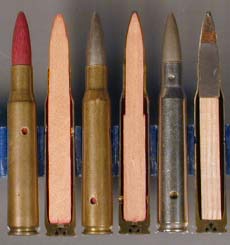
British dummies – note the use of a swaged
.303 bullet on the pair on the right.
Because dummies were made with rejected and experimental cases, it is
a good idea to look at the headstamp closely. Several steel-cased U.S.
dummies have turned up that had a Frankford Arsenal headstamp (F A date)
with either the “F” or the “A”, or the date omitted from the headstamp.
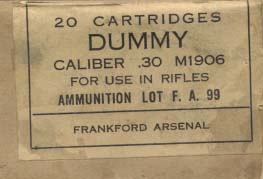
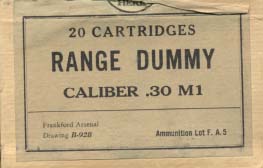
Perhaps one of the most unusual U.S. dummies is that designed for the
Hollifield Target Practice Rod device. This ingenious device fitted in
the barrel of the M1903 rifle and was essentially a rod with a sharp point
on the end. These special dummies, which also had a rod in them, were placed
in the chamber. “Firing” the rifle resulted in the rod in the cartridge
transmitting the blow to the rod in the barrel which popped out of the
muzzle, pricking a paper target held just in front of the rifle. These
dummies were made from fluted and smooth cases. Look for the slightly protruding
rod at the bullet tip.
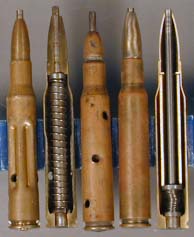
Frangible
While .30-06 Frangible rounds are common, the story of their development
is not well known. They were actually developed during WWII by Duke and
Princeton Universities as part of a government contract. The intent was
to develop a bullet that could be used to train bomber gun crews by allowing
them to fire at a real aircraft. It took several years to arrive at a suitable
bullet (and an armored aircraft for that matter). The common mottled grey-green
bullet is actually a mixture of powdered lead and Bakelite, officially
referred to as RD-42-93. Usually found with green and white bullet tips,
they can sometimes appear with either no tip color or just white tip. In
the majority of cases, these are simply rounds that have escaped the complete
painting process. Those loaded on commercial cases (as opposed to having
a military headstamp) might, repeat “might”, be from the early experiments
at Duke and Princeton.
Initially called the T44, the frangible was adopted as the M22. A round
with a different powder and a tan and green bullet tip was called the T74.
One unusual frangible round has a short sharp bullet with a black tip
(and a hemispherical base) and was actually for testing the armor plate
on the target aircraft.
There is an extremely rare and often faked Frangible Tracer, identified
by a red and white bullet tip. Because the trace cavity in the bullet was
unsealed and trace compositions expand over time, most of these have long
since broken apart.
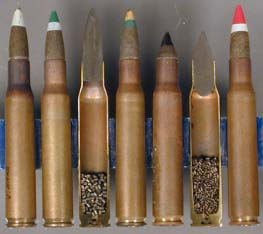
Frangibles: Paint process escapee; regular T44; T44 sectioned; T74;
plate test & section; and Frangible Tracer.
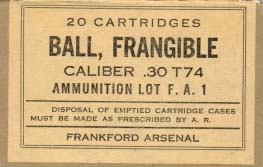
Gallery/Guard/Short Range
I’ll cover these together since though they started off as different
rounds they did eventually end up as the same cartridge filling both roles.
Since guards were often posted on installations in urban areas, it was
felt that a normal ball cartridge posed too much danger to local residents
if one was fired in anger. Having a cartridge that could be used in these
circumstances was the rationale for the early Guard loads. The first U.S.
type simply used the ball bullet and a small powder charge. It was identified
by 5 smooth cannelures on the case. These cannelures were its undoing as,
in a dirty chamber, these weakened the case sufficiently that cases would
separate at the cannelures leaving the remains of the case stuck in the
chamber. The remedy was to switch the identification to 6 short dents or
flutes on the shoulder.
Gallery rounds were, as their name implies, for training purposes on
ranges not equipped for the full service round. In the U.S. there was quite
a bit of experimentation around WWI though specimens of these tests are
virtually impossible to find. They resulted in the common round-nosed lead
bullet and the slightly pointed “Ideal” bullet in the service case. Any
case was used including reclaimed cases (often marked with a line across
the headstamp). Cases and loose bullets were also supplied to militia units
so it is not easy to tell what is a factory specimen. In 1933, the M1919
Gallery round with the smooth round-nosed lead bullet was classified as
the M1 Guard cartridge. In the early 1930s Frankford Arsenal experimented
with a “Short Range” series with hollow and wood-cored bullets. Some of
these had round noses. While these are not common it is always worth checking
to see if a bullet feels light. Most of these were headstamped F A 30.
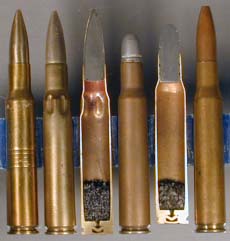
Guard/Gallery rounds: Early M1906; Late M1906; Late M1906 sectioned; M1919
Gallery: sectioned gallery; hollow jacket experimental from FA.
Outside the U.S., countries like Norway and Sweden experimented and
adopted gallery or short range cartridges utilizing plastic bullets or
very light short hollow bullets. Many of these also used plastic cases.
One quite interesting one has a red plastic case which extends up to also
form the core of the bullet which has a copper jacket (see photo below).
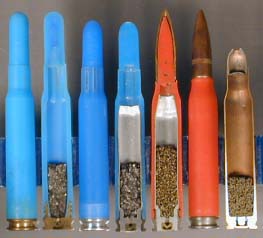
Norwegian short range cartridges
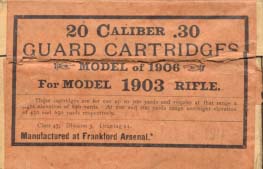
High Pressure Test / Pressure Test /Proof
While I have lumped these together, there are subtle differences in
their usage. A High Pressure Test (HPT) or Proof round is intended to place
more than normal stress on a chamber to ensure that it can stand the wear
and tear of a military or hunting life. A Pressure Test cartridge is loaded
to a specific pressure which may be a equal to a load it is intended to
duplicate or sometimes less depending on its use.
U.S. military HPT rounds were usually identified by a tinned case. Early
ones from the U.S. also used a pointed lead bullet. As this was hardened
lead it had a blue sheen and was given the nickname “Blue Pill”. Commercial
HPT rounds were usually tinned but often had a red bullet and base. Some
foreign countries used copper-washed cases or knurled rims to identify
HPT rounds. Because an HPT round can be needed at various stages of weapon
manufacture, there are some that have no extractor groove and also a rare
one that is for an unfinished chamber that is thinner than a standard round.
These are called “Autofrettage” rounds and are difficult but not impossible
to find.
Cartridges with headstamps of FA TEST are assumed by many collectors
to be HPT rounds. While some HPT rounds were so marked, the FA TEST headstamp
was used extensively by Frankford Arsenal to identify many internal experimental
rounds.
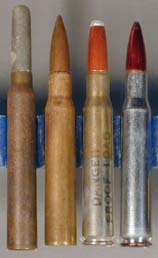

HPT rounds: Autofrettage, rimless-grooveless (FA TEST headstamp); commercial
proof with red bullet and half tinned case with DANGER PROOF LOAD stenciled
on case; Israeli HPT with red base and bullet
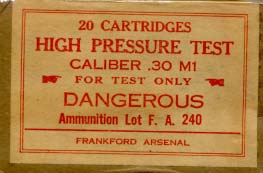
Incendiary
While the incendiary effect of such a small bullet was often questioned,
work continued over two decades to perfect it. The first type of incendiary
officially used in the U.S. had a blackened flat-tip bullet that used a
phosphorous filler between lead slugs. These are more often encountered
without the blackened bullet and it was called the M1917 Incendiary. This
was quickly changed to a blackened bullet with a normal profile but the
same internal composition and referred to as the M1918.
By WWII, a bullet that was easier to manufacture was developed that
used a barium nitrate and magnesium compo sition (IM-11). Initially called
the M1 Incendiary with a gilding metal base plug, it was altered to use
a simpler lead base plug and called the M1 Alternate Incendiary. Identification
of both was by a blue bullet tip. These will be found on cases from a variety
of WWII U.S. manufacturers.
Most foreign manufacturers don’t appear to have bothered with a .30
caliber incendiary. The exception being Belgium (FN) with its blue tip.
French cartridges with a blue tip exist but all examined so far appear
to be ball rounds with blue tips. Whether these are fakes or intended for
another purpose is not known.

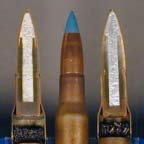
Incendiary Rounds
Explosive
Given the relatively small size of the .30 caliber bullet, it is surprising
that anyone would consider designing an explosive bullet for it – but they
did. To be fair, most of these were intended to be “Observation” rounds
where the detonation of the bullet confirmed that one was on target.
Early U.S. experiments included a 1919 round called the “Supersensitive
Explosive” round. This was most unusual in that it had a nipple-like firing
pin protruding from the bullet nose. It remains rare but can be seen in
advanced collections. There are actually several variations but most collectors
would be pleased to have just one!
A true explosive round was developed by Winchester for the U.S. Government
in 1940. This is called the Pomeroy after the guy who patented the design.
The nitroglycerine explosive element is enclosed in a copper tube in the
bullet nose and activated by the bullet rotation concentrating it against
the side of the tube. It was loaded on cases headstamped W.R.A. .30-,06.
While they were supposed to have a green tip, this seems to come off easily
and most have no visible signs to identify them – they look like a normal
copper-tubed hunting bullet.
In the late 1940s Frankford Arsenal and Winchester again experimented
with an observation bullet identified by a yellow tip and this was the
T99 Observing. This is most often found with a WRA 51 headstamp. Rounds
headstamped F A 52 with yellow tips are not unusual but many of these are
inspectors dummies loaded with dummy powder and primer.

Supersensitive Explosive; Pomeroy & T99 Observing
A couple of U.S. companies made “commercial” explosive rounds – Velet
and Hi-Vel being two. They were not intended for military use.
Match
In the early 1900s, the U.S. Government invited commercial ammunition
manufacturers to submit cartridges for the trials for the various national
and international matches. This allowed these manufacturers to come up
to speed in .30-06 production methods. Rounds from companies like Remington,
Winchester, U.S.C.Co. etc can be found with military headstamps dating
from before WWI and these were from those submissions.
It wasn’t until 1921 that the U.S. started headstamping match rounds
to identify the match and year, but they continued the practice into the
1960s Headstamps can include NM for National Match, IM for International
Match, PM or P for Palma Match. R indicating a Rifle Annealed case – used
in a variety of matches. I & P for International and Palma, etc.




![]()
![]()




Apart from the headstamps and occasionally a greater than normal overall
length there is little to excite the collector when it comes to match rounds.
There are a couple that are very hard to find – eg: FA INM 25, and one
that was known to have been made in the thousands but has never been seen
since (F A 41NM).
A round you will occasionally come across has a headstamp commemorating
the 50th Anniversary of the .30-06. Is was originally made as a nickel
plated dummy but a number were loaded in brass cases as match rounds.
Apart from Norway, other countries did not use the .30-06 to any great
extent for matches. However, Norway has some interesting headstamps on
some of their match rounds.



Match rounds: 50th Anniversary; RAufoss/NOrma, Norway.
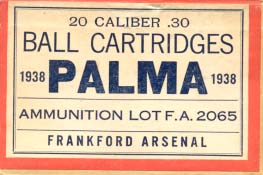
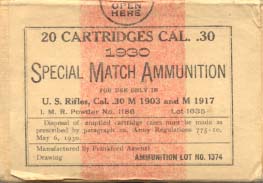
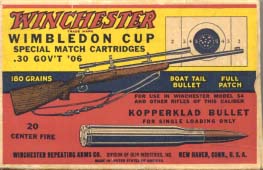
Multiball
The idea of increasing firepower by increasing the number of bullets
fired by a single cartridge is nothing new. However, the early Greener
experiments and the U.S. Project Salvo gave the .30-06 collector some interesting
items to look out for. The Greener experiments, conducted in the UK on
U.S. cases, produced duplex (2 bullets) and Triplex (3 bullets) rounds.
Normally, these are found on cases dated from the immediate pre WWI period
with three flutes from the shoulder. The length of the flutes varies. Remington
did make “Greener” cases and the bullets but it is not known if they were
for the UK tests of for ones being performed in the U.S.
Greener rounds, especially in good condition, are very rare as the lower
bullet had a steel jacket that corrodes and expands – splitting the case.
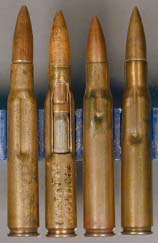
Greener Multiball rounds. Third from left is a duplex.
Easier to come by are the rounds from Project Salvo (1952-61) which
involved Olin Mathieson (parent company to what we call Winchester and
Western). These used either standard-length cases or cases with an extended
neck. On standard-length cases, the case held either 2 (96gr) or 3 (60gr)
bullets. You cannot tell reliably how many bullets without x-raying the
round. You can find them with the top bullet marked with a red, blue or
black tip, or entirely red. The significant of these color codes has yet
to be determined.
On the long-neck version, the duplex rounds have crimps on the case
neck about 1/10-inch above the shoulder. The triplex load has crimps at
the juncture between the neck and the shoulder. The long-necked rounds
can also be found with the same color coding as mentioned above, and used
the same bullets.
One interesting fact is the use of a small powder change between
the bullets to aid in separation.
Rounds from this series bear headstamps such as WRA 53, SUPERSPEED 30-06
SPRG, WCC 57 and FA 58 MATCH.
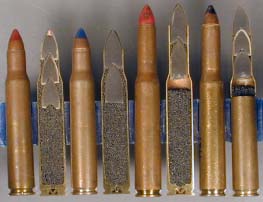
Tracer
Probably the earliest .30-06 tracer that the average collector will
come across is the M1917 with its blackened case and cupronickel bullet.
Headstamps are usually from Frankford Arsenal or WRACo. Quite a few of
these were produced without the blackened case which makes them difficult
to tell from ball rounds of the period.
There was considerable experimentation in the period following WWI with
both short and long trace cavities in the bullets. In 1921, the bullet
jacket was changed from cupro-nickel to gilding metal. While the U.S. did
introduce a short-lived M1923 tracer, the commonly encountered ones are
the M1924, again with a blackened case. This was loaded in Green Tracer
and Red Tracer – sometimes denoted by a drop of red or green translucent
lacquer over the primer. The green tracer was eventually dropped and by
1926 the red tracer was renamed the M1 Tracer. In 1930, the case blackening
was dropped and the identification changed to a red bullet tip. The M1
Tracer remained in service until well into WWII. In 1943, to combat a copper
shortage the steel bullet jacket was introduced which earned it the title
of M1 Alternate Tracer. Around this time the U.S. developed a tracer with
a short burn time and this was adopted as the M2 Tracer in 1942 and identified
by a white bullet tip. This identification was short-lived and was changed
to a red bullet tip with an additional knurled cannelure on the bullet
above the case mouth. The white tip version was made for a short time by
many of the WWII Ordnance Plants.
In 1942, the U.S. Air Force determined that a dim ignition tracer was
warranted – one that wouldn’t blind the pilot. The T10 Tracer was developed
during early 1943 and identified by a dull orange tip. It had headstamps
of F A 4 and F A 45 and is not hard to find if you know what you’re looking
for. In July 1945 the T10 became the M25 with a bright orange tip and this
remained the official U.S. service tracer for the rest of the life of the
caliber.
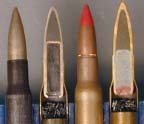
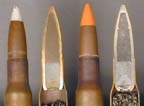
U.S. Tracers: M1917 (and section), M1 (and section), M2 early (and section), M25 (and section).
While many foreign countries followed the U.S. tracer design and marking,
quite a few did not. Most also had subtle variations in how the tracer
bullets were constructed but space limits us describing them all here.
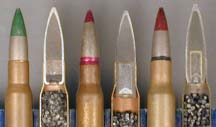
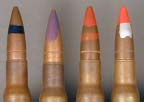
Foreign Tracers: Argentina (and section), Belgium (and section), France
(and section). If you like different color tips – the four at right are
1950s & 1960s experimental tracers from England.
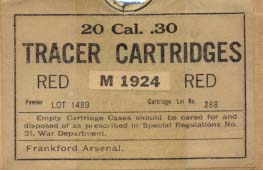
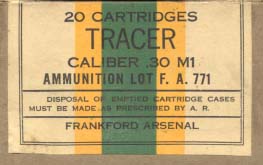
Sporting
Almost every commercial ammo manufacturer in the world produced .30-06
in as many bullet variations as the market would stand. It would be impossible
to cover them all here so I will show just a couple of the “exotic” but
easily available variations. In addition, some of the boxes are highly
prized from makers such as Remington and Winchester-Western.
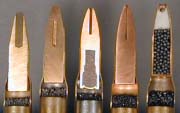
From left: Austrian “ABC” bullet; German “SFS”; Winchester Black Talon,
Barnes “X-bullet”; Glaser Safety Slug.
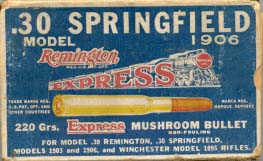
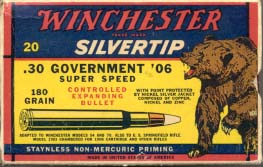
Experimentals
It would be an impossible task to describe all of the literally hundreds
of experimental .30-06 that are available here. These are not just from
the U.S. but countries like Norway, Belgium, and England who did extensive
tests of their own with the caliber. All I can hope to do is to describe
a handful of experimental rounds that you can find relatively easily.
Any caliber like the .30-06 has rounds that were used to test case materials,
primer compositions/designs and, of course, bullets for a special purpose.
Through the 1920s, the U.S. experimented with different primers in an
attempt to get away from the corrosive compounds of the time. Some of these
tests were identified by special headstamps. Additional tests on primers
occurred in the 1930s and again after WWII. Some were plated with tin,
nickel or zinc but that alone does not automatically mean a primer is an
experimental. In the late 1940s, the U.S. used zinc plating to protect
primer cups on the then new P4 primer.



From Left: Garand Primer, Berdan #11 and #30 primers
In the U.S., experiments in alternative case material and coatings occurred
from about 1919 through WWII. Mostly this was to reduce the reliance on
strategic metals like copper or tin and the focus was on steel cases. The
great problem was always protecting the steel from corrosion so most of
the experiments with steel cases concentrated in finding an easy to apply
coating. With the exception of F A 19 steel cases which are relatively
rare, most of the experiments occurred during WWII and were conducted by
Frankford Arsenal though plants such as Lake City, and Twin Cities were
involved as was Winchester. Look for steel cases with copper, brass or
zinc plating – this is where a magnet is invaluable for spotting the brass/copper
washed steel case in a “grab box”. Be aware that by 1942 the U.S. had accepted
the steel case with a zinc-cronak finish. This gives the cases a dull yellowish
look. However, certain storage conditions can discolor this finish and
some unscrupulous people have been known to polish the coating off – leaving
plain steel. Check for signs of plating in the extractor groove or in the
letters of the headstamp. Most experimental case finishes appear on cases
headstamped 1942 or 43, or with no headstamp – the latter being not hard
to find. Frankford Arsenal Laboratories, where much to the development
work was performed sometimes used the FAL 43 headstamps to mark experimental
rounds.


Headstamps on Experimental Cases
In 1955, Frankford loaded some AP rounds and coated both the steel case
and the bullet with green Teflon. Apparently this was to see if it reduced
“cook-offs” in hot chambers though many assume they were for “Arctic” testing.
Aluminum cases were tested at various times by both Frankford Arsenal
and Winchester. They aren’t easy to get but they turn up at cartridge shows
and auctions on a regular basis. Aluminum cases with headstamps of F A
25-R, F A 30, F A 34, FA TEST, FAL 43 and WRA *50* exist.
As well as looking at different case materials, places like Frankford
also looked at improving production methods. At various times, they tried
making cases with an extrusion process rather then the normal drawing process.
These cases sometimes used special headstamps to identify them. Three of
the more common ones are shown below.



Extruded Brass Cases
Several attempts to come up with alternative coating or construction
of ball bullets are worth mentioning as specimens are not uncommon.
In 1943, the Western Cartridge Company tested bullets that had a baked
finish on the steel jacket giving them a gloss dark grey to black finish.
These finishes were called “Luberized”, ” Bonderized”, and “Jetalized”
– the latter being the darkest. All were loaded on cases headstamped SL
43 (Western was running the St. Louis plant for the Government).
In the late 1930s, Frankford experimented with “Oilite” bullets – a
material made from compressed powdered metal with a lubricant. Materials
included powdered bronze, copper, steel, and mixtures of both. Most matched
the shape of the regular ball bullet but several were made with a blunt
ogive. The common headstamp is F A 36 though some are marked F A 41. Look
for a slightly mottled appearance to the bullet or a slight but regular
reaction to a magnet. One of these experiments actually had a steel rod
for a core (see below).
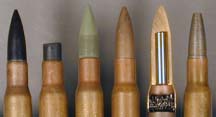
From left: Jetalized bullet; Fragmentation Test; “Bernstein” bullet; Oilite
bullet, and section showing core; Hebler Tubular bullet.
Other unusual loads to look out for include the Fragmentation Test rounds
loaded on cases marked S L 5 5. These used a steel wedge-shaped slug (blackened
and plain) to simulate shell fragments for testing armor and helmets.
You will sometimes come across a round that has a serrated steel bullet
with a green Teflon coating – usually in cases marked F A 5 5. These are
occasionally referred to as “Bernstein” bullets after a German engineer
who developed similar bullets in WWII though he was not employed at Frankford.
These serrated bullets were also loaded without the Teflon coating but
they are quite rare.
One last round worth mentioning is loaded with a steel tubular bullet
on cases marked F A 5 8 (see above illustration). These use a “Hebler-style”
bullet that has a pusher sabot. The bullets actually date from the late
1890s and were loaded on the .30-06 in 1958 for purposes unknown.
Space prevents me from delving any deeper into the experimental .30-06 – I
have not even begun to scratch the surface. Just to wet your appetite still
further: Did you know there was a silent .30-06 cartridge? Did you know that
a 340 grain softpoint was loaded by Winchester? Did you know there was a 5-bullet
squeezebore .30-06? How about a teargas loading, or an electronic equipment
destructor, or ones with the lot number stamped on the side of the case, or…,
or….
I have mentioned cartridge shows and auctions as sources for .30-06. While
you will find a good many .30-06 at gun shows and it will help if you know what
you’re looking for, the more unusual rounds come from other collectors and only
show up at cartridge meetings and auctions. If you can’t get to shows and are
wary of auctions, make sure you join a collecting organization (the IAA is a
great place to start). This will put you in touch with other collectors.
I have used a number of illustrations of sectioned
cartridges (also called “cutaways”) in this article. DO NOT try sectioning ammunition
– it requires specialized tools and specialized knowledge. You only have one
pair of eyes and one pair of hands – keep them!
For further reading on the .30-06 I can suggest a few books with specific
reference to the caliber:-
History of Modern U.S. Military Small Arms Ammunition by Hackley,
Woodin & Scranton, 2 volumes covering, amongst other calibers, the development
of .30-06 at Frankford Arsenal from 1906 to 1945.WRACo by Dan Shuey. Covers WRACo headstamped rounds including the
.30-06..30-06 We have Seen, Volumes 2 & 3. by G.F. Marcello. A checklist
of headstamps found on .30-06 up to 1986..30-06 by Chris Punnett. A hard-bound 384-page volume covering the
development and production of the .30-06 in 48 countries from its inception
to the early 1990s.
|
I highly recommend joining the International Ammunition Questions about this article |




